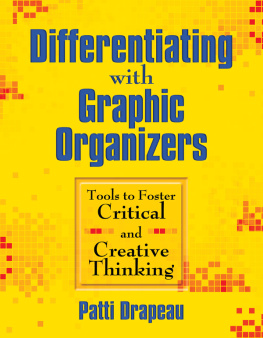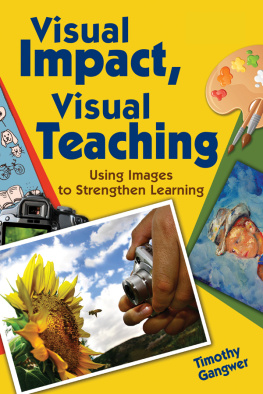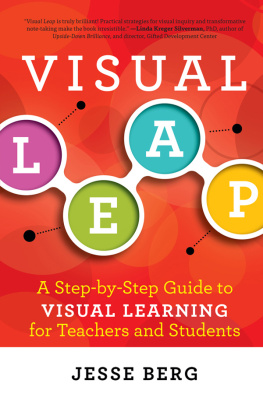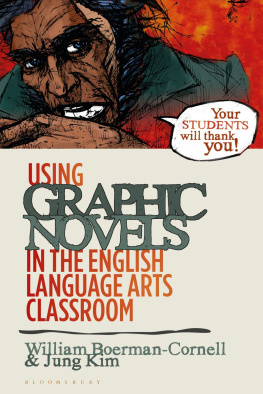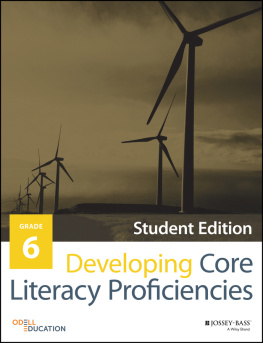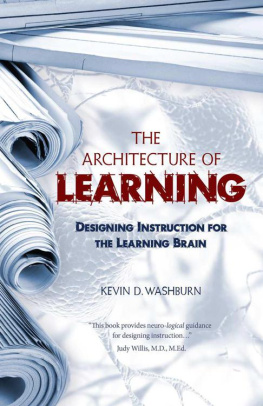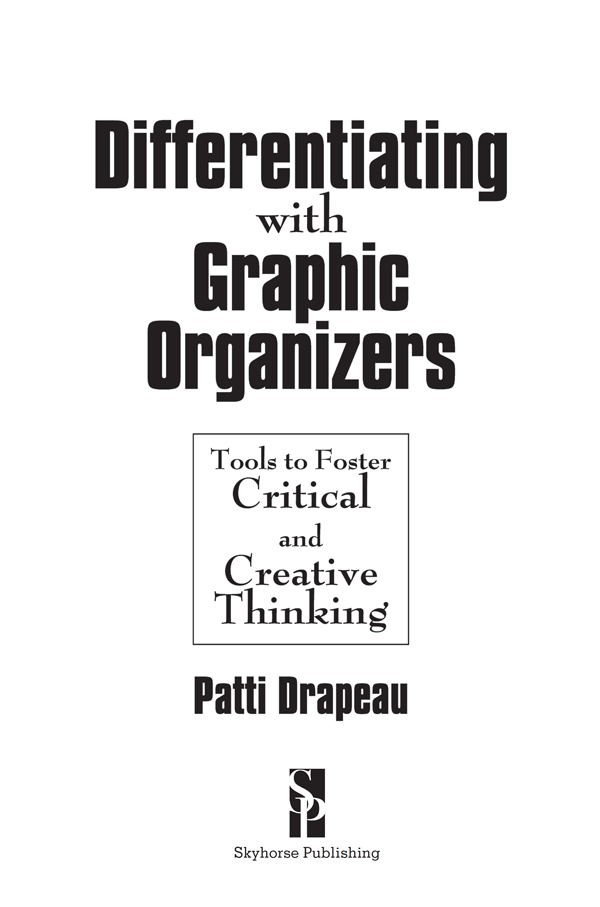
Copyright 2009 by Corwin Publishing.
First Skyhorse Publishing edition 2016.
All rights reserved. No part of this book may be reproduced in any manner without the express written consent of the publisher, except in the case of brief excerpts in critical reviews or articles. All inquiries should be addressed to Skyhorse Publishing, 307 West 36th Street, 11th Floor, New York, NY 10018.
Skyhorse Publishing books may be purchased in bulk at special discounts for sales promotion, corporate gifts, fund-raising, or educational purposes. Special editions can also be created to specifications. For details, contact the Special Sales Department, Skyhorse Publishing, 307 West 36th Street, 11th Floor, New York, NY 10018 or .
Skyhorse and Skyhorse Publishing are registered trademarks of Skyhorse Publishing, Inc., a Delaware corporation.
Visit our website at www.skyhorsepublishing.com.
10 9 8 7 6 5 4 3 2 1
Library of Congress Cataloging-in-Publication Data is available on file.
Cover design by Rose Storey
Print ISBN: 978-1-63450-777-6
Ebook ISBN: 978-1-63450-788-2
Printed in the United States of America
Contents
Acknowledgments
I would like to thank the many educators, colleagues, friends, and family members who supported me as I made my way through the idea generating, field testing, and writing stages of this book. I would like to recognize the work of educators who have influenced this material and in particular Richard Paul, Lorin Anderson, David Krathwohl, Robert Marzano, Matthew Lipman, Carol Ann Tomlinson, Sandra Kaplan, Eric Jensen, and Mel Levine.
I would like to thank the following teachers who field tested the graphic organizers at the elementary, middle, and high school levels: Terrance Gould, Melissa Antrim, Jen Blair, June Lajeunesse, Leah Matvay, Danae Secunde, Marianne Stephenson, Cindy Thorne, Heather Chambers, Doreen Carson, Ed Disy Melanie Ekstedt, Janice Fickett, Celeste Frisbee, Joshua Gagnon, Kristen Gentile, Katie Knox, Michael Levine, and Lynn Mercier.
I would like to thank my colleagues who provided support when this book was still in manuscript form. They are Dr. James Curry, Dr. Diane Heacox, Karen Shible, Pam Lester, Ira Waltz, and Dr. Cecilia Boswell.
I would like to thank the Skyhorse Publishing team who enabled this book to come to fruition. I am grateful to Alison Sharp for her commitment to the book. Thank you to Carol Collins for her editing efforts and her help in structuring the book. I would like to thank Brett Ory for her assistance and feedback. I would also like to thank copy editor Taryn Bigelow for her ability to edit with an eagle eye. Her comments were invaluable in moving the book into its final stage. I would also like to thank the production editor, Veronica Stapleton, for her guidance and support.
Thank you to my family and friends who were incredibly supportive of me while I was writing this book. Their love and support helped me on my journey and continue to enrich my world.
PUBLISHERS ACKNOWLEDGMENTS
Skyhorse Publishing thanks the following reviewers for their contributions to this work:
Sarah Miller
Resource Teacher
Baldwin County Schools: Orange Beach Elementary
Orange Beach, AL
Jennifer Sinsel
Science Teacher
John Marshall Middle School
Wichita, KS
Joseph Staub
Resource Specialist Teacher
Thomas Starr King Middle School
Los Angeles, CA
Brigitte Tennis
Head Mistress and Seventh Grade Teacher
Stella Schola Middle School
Redmond, WA
Robert E. Yager
Professor of Science Education
University of Iowa
Iowa City, IA
About the Author

Patti Drapeau is teacher, trainer, author, an internationally known presenter, and educational consultant. She has more than twenty-five years of classroom experience teaching students and coordinating programs in Freeport, Maine. Patti currently serves as adjunct faculty at the University of Southern Maine where she teaches graduate courses in Differentiation, Critical and Creative Thinking, Curriculum Integration, Education of the Gifted and Talented, and Curriculum and Methods for Teaching Gifted and Talented Students. Patti is also a certified trainer for the IIM (Independent Investigation Method) Research Model.
Patti developed a curriculum model for the regular classroom called Affective Perspectives: Combining Critical Thinking, Creative Thinking, and Affect. She has authored a variety of articles for the Maine Exchange and is the author of two books published by Scholastic, Great Teaching With Graphic Organizers and Differentiated Instruction: Making It Work .
Patti is an international presenter in the United States and Canada, where she has appeared at many national, state, and regional conferences. As an educational consultant, she conducts district and school workshops focusing on different ways to meet the needs of all students. She may be contacted through her Web site, www.pattidrapeau.com.
This book is dedicated to those teachers who seek and are willing to risk change. May your courage and spirit endure .
Introduction
From Potential to Performance
E ducators are and I hope always will be concerned with their students level of achievement. We believe an overarching goal in education is to help all students move from potential to performance. To this end, we have spent millions of dollars and hours conducting scientifically based research studies to find the magic answer to the age-old question: What can we do to help our students achieve? What can we do to bring students up to grade level or challenge them beyond grade-level expectations? How can we help students achieve all they can achieve?
I have come to realize that one basic problem exists. Our definition of achievement is relative: What one person says is an acceptable level of achievement another thinks is unacceptable. Sometimes a student has an exceptional personality or a singular talent, but cant achieve academically. In school, such a student is viewed as unsuccessful. The student feels like a failure. In fact, from a purely academic viewpoint, their grades and their inability or unwillingness to meet state standards verify this. In school, it is what you do academically that counts. But we cannot separate who the learner is and what the learner does, because achievement affects self-esteem and self-confidence, and self-esteem and self-confidence affect achievement. Achievement cannot be easily or narrowly defined or measured.
TRENDS IN ACHIEVEMENT
In the search for answers, many educational fads have come and gone. In the 1970s, thinking skills was the latest fad. Educators claimed that teachers werent asking their students to think deeply about content. The fear was that students were learning information at a rote level, quickly forgetting what they learned or never really learning it at all. The thinking skills movement took hold and high-level verbs became the rage. Blooms Taxonomy became the guiding light and teachers classified their questions accordingly.
But soon, some teachers protested: If we spend too much time focusing on thinking skills, content will be compromised. There wont be enough time to teach content. Articles began to appear in educational journals with titles such as Content Versus Thinking Skills. The debate continued for years.

